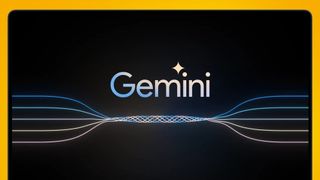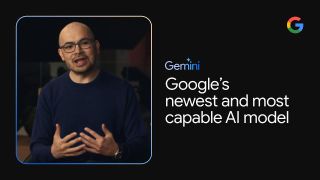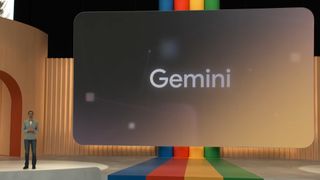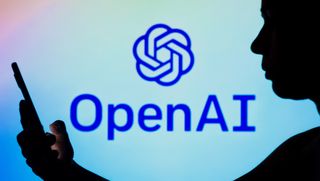What is Google Gemini? Everything you need to know about Google’s next-gen AI
All of your big Gemini questions, answered

Until recently, OpenAI has been the dominant force in the world of artificial intelligence (AI) and chatbots, with its GPT-4 large language model (LLM) powering ChatGPT (not to mention Microsoft’s Copilot) and taking the world by storm. The company got an early lead and everyone else has been playing catch-up ever since.
Yet OpenAI has a fresh challenger in the form of Google Gemini. This new arrival burst onto the scene in February 2024 (after being announced at the end of 2023) and immediately made some big waves in the AI world.
But is it enough to defeat GPT-4? What can it do right now, and what about in the future? And if you want to use Gemini, how exactly do you do that? We’ve taken a deep dive into the world of Gemini to find the answers to all these questions and more. If you’re curious about Google’s latest AI efforts, this is the place to be.
Editor's note: With Google I/O 2024 taking place on May 14, at the time of writing, we expect to hear a lot more about Gemini and what it could do next; this will likely include what devices can tap into and will feature in, the most recent being the Google Pixel 8a. For a beat-by-beat breakdown of the keynote make sure to follow our Google I/O live blog.
What is Google Gemini?
Gemini is Google’s latest large language model (LLM). What’s an LLM? It’s the system that underpins the types of AI tools you’ve probably seen and interacted with on the internet. For example, GPT-4 powers ChatGPT Plus, OpenAI’s advanced paid-for chatbot.
Gemini is more than an AI model, though, as it’s also the new name and identity for the Bard chatbot. Yes, Bard is no more and has been fully replaced by Gemini. Essentially, Google has simplified things by calling both the underlying model and chatbot itself Gemini. Furthermore, there’s a free Gemini app for Android now, and Gemini can replace Google Assistant on your Android phone if you wish. On iOS, Gemini is present within the Google app.

On top of all this, Google has rebranded its Duet AI service, aimed at businesses, as Gemini for Workspace, with a whole bunch of productivity-related chops on offer.
Get daily insight, inspiration and deals in your inbox
Sign up for breaking news, reviews, opinion, top tech deals, and more.
The final twist is that as well as the basic (free) version of Gemini for consumers, there is also a subscription offering for the AI known as Gemini Advanced. This paid product is based on a more powerful LLM called Gemini Ultra, and those signed up to the Google One AI Premium subscription get extra benefits from using this model.
To sum up, all Google’s AI properties are now under the Gemini umbrella to simplify things, whether that’s AI for consumers or businesses, and whether accessing Gemini via the web, or the assistant or app on your smartphone.
What can Gemini do?
The short answer to this question is: a lot. But you probably want us to elaborate a bit more than that.
As we’ve just discussed, Gemini is an expansive umbrella for a whole lot of AI features and functionality delivered via different avenues.
As Google explained in a press release when Gemini was first revealed, the AI is a multimodal tool. In other words, it can deal with various forms of input and output, including text, code, audio, images and videos. That gives it a lot of flexibility to perform a wide range of tasks.
However, there are two separate LLMs that Google has implemented with its AI. They are Gemini 1.0 Pro, the engine which powers the free version, and Gemini 1.0 Ultra, which drives the subscription AI (Gemini Advanced). And yes, it hasn’t escaped our attention that this simplification of moving everything under the Gemini brand comes with ironic complications and a level of confusion of its own (with Gemini this, that, and the other, as names for the various engines and products).
All you really need to know is that Gemini Pro, the free version, is a much simpler model which is less accurate and lacks the creativity and depth of the paid Gemini Ultra LLM.
So, what can Gemini Pro actually do? It can answer simple questions, summarize text, and create images. Also, it plugs into other Google services: Gemini is hooked into the likes of Gmail, Google Maps, and YouTube. So if you ask it for sightseeing recommendations, for example, it will flag them up in Google Maps.
There are some nifty abilities for sure, and those with Android smartphones get even more mileage for free with the Gemini app. As already mentioned, this can replace Google Assistant on an Android device, if you wish, running queries and working its AI magic via other Google services (Maps, search, even Assistant itself, which isn’t actually chucked off your phone as such, and still lurks underneath). You don’t have to replace Assistant with Gemini, either, and can instead elect to use the Gemini app whenever you want the AI to weigh in and lend a helping hand.

That choice may lead you to wonder: is Gemini a good replacement for Google Assistant? Well, we covered this extensively in our hands-on with Gemini on Android, and there are certainly drawbacks with the AI. Gemini is noticeably slower than Google Assistant, and the AI still has bugs. For instance, it’s supposed to be able to interact with photos, but is still glitchy (at the time of writing) with this functionality.
That said, the initial Gemini on Android experience was a lot wonkier than it is now. For example, there were some basic missteps with the interface (a major issue was quickly corrected, mind). Another example that springs to mind is that Gemini was supposed to deal with smart home gadgets, but failed in that task when we tried it initially - but more recently, this feature has come good and now works.
It seems that Google is ironing out the problems with Gemini on mobile pretty swiftly, which is heartening to see, and the results with the Gemini app can be impressive. There are still wrinkles to smooth over in terms of replacing Google Assistant on Android, but that should come in time.

Overall, then, the freebie version does give you a lot to get on with, especially for Android users. However, the paid take on Gemini is actually far more in-depth.
Gemini Ultra (the model powering the Gemini Advanced subscription product) brings a whole range of powerful abilities to the table, such as handling multi-step queries, and providing help with more complex tasks like coding. On a general level it’s also more accurate in terms of pinning down better and more organized answers to queries.
For those who use Google’s productivity apps, Gemini will soon be available in Google Docs, Gmail, and more, we’re told, but only for Advanced subscribers.
Finally, it’s worth noting that Google is already working on its next-generation Gemini 1.5 model, which will push both LLMs to new heights with Gemini 1.5 Pro and Gemini 1.5 Ultra.
Gemini 1.5 Pro is in early testing right now, in fact, and can handle longer prompts, offering what Google describes as “dramatically enhanced performance” no less. In a test example, Gemini 1.5 combed through a 400-page transcript of the Apollo 11 moon landing and was asked to extract “comedic moments” from the mission. It duly obliged by picking out a few jokes told by the astronauts, and only took 30 seconds to do so. Impressive.
When was Gemini released?
Google Gemini was released on February 8, with Google confirming that it replaced Bard which was put out to pasture. Gemini was available immediately, in both its free form, and the paid version, Gemini Advanced. Google also began the rollout of the Android app in the US straight away.
That US rollout was completed in the space of a week, so went pretty swiftly, but the Gemini Android app hasn’t yet been seen elsewhere - although we’re told that it’s coming to more countries soon. While iOS availability lagged behind, Gemini is now available on Apple smartphones too (as part of the Google app, that is, in a more limited form compared to Android).

Is Google Gemini free?
The standard version of Google Gemini is free, but it’s more limited than the paid spin on the AI. As we’ve already discussed, the free Gemini AI is based on a simpler model, whereas those who pay a subscription for Gemini Advanced get a lot more depth in terms of features and capabilities.
How much is Gemini Advanced? Google charges $19.99 / £18.99 / AU$32.99 per month, but you can try it out for a limited time for free, as a two-month trial is currently available. The subscription comes with other benefits, though, as Gemini Advanced is actually part of the Google One AI Premium Plan, which also provides 2TB of cloud storage among other extras.
Given that Google One with 2TB of storage already costs $9.99 / £7.99 / AU$12.49 per month, if you need a cloud storage locker, Gemini Advanced looks a more tempting value proposition.

How do I use Google Gemini?
The way you use Google Gemini depends on the version you’re interested in and the product it has been woven into.
You can head to the Gemini website and use the AI there in the typical way you interact with an online chatbot (in other words, just like Google Bard).
Or you can use the Gemini app on your Android phone (or replace Google Assistant with Gemini, as noted). Or on iOS, you can head to the Google app for Gemini functionality. Oh, and rumor has it you may even be able to use Gemini on your headphones soon (if they are optimized for Google Assistant, like the Google Pixel Buds Pro for example).
Finally, there’s the additional and separate option of subscribing to Gemini Advanced, to get the full AI experience including sharper responses, dealing with complex tasks and demanding creative needs, and the other benefits we’ve outlined above.
Gemini vs GPT-4: what’s the difference?

How does Gemini stack up against GPT-4 in the battle of the large language models?
For one thing, when Gemini was first revealed, Google claimed it’s more advanced than GPT-4. In a blog post, Google showed results from eight text-based benchmarks, with Gemini winning in seven of those tests. Across 10 multimodal benchmarks, Gemini came out on top in every one, according to Google at least.
That would seem to imply that Gemini is the superior system, but it’s not quite so straightforward, of course. GPT-4 came out in March 2023, so Gemini is essentially catching up to a rival AI tool that’s almost a year old. We don’t know how capable OpenAI’s next version of GPT will be, and there’s a world of nuances in this battle outside of Google’s own limited benchmarking, so it’s hard to say which is truly the better tool at the moment.
As well as that, Google only put its more advanced model, Gemini Ultra, up against GPT-4, and not Gemini Pro. Given the often-slim margins between GPT-4 and Gemini Ultra, it seems likely that OpenAI’s model comes out ahead of Gemini Pro.
You might also like

Alex Blake has been fooling around with computers since the early 1990s, and since that time he's learned a thing or two about tech. No more than two things, though. That's all his brain can hold. As well as TechRadar, Alex writes for iMore, Digital Trends and Creative Bloq, among others. He was previously commissioning editor at MacFormat magazine. That means he mostly covers the world of Apple and its latest products, but also Windows, computer peripherals, mobile apps, and much more beyond. When not writing, you can find him hiking the English countryside and gaming on his PC.